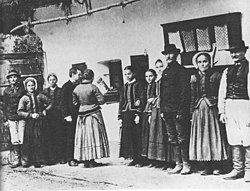General
Field recording often involves the capture of ambient noises that are low level and complex, and, in response, the requirements from the field recordist have often pushed the technical limits of recording equipment, that is, demanding low noise and extended frequency response in a portable, battery-powered unit. For this reason, field recordists have favoured high-quality (usually professional) recorders, microphones, and microphone pre-amplifiers. The history of the equipment used in this area closely tracks the development of professional portable audio recording technology. Modern accessories used in the field include, but are not limited to: windscreens (foam, fur, hair, parabolic reflector), shock mounts, microphone cables, digital audio recorders and so on. [1]
Field recording is typically recorded in the same channel format as the desired result, for instance, stereo recording equipment will yield a stereo product. In contrast, a multitrack remote recording captures many microphones on multiple channels, later to be creatively modified, augmented, and mixed down to a specific consumer format.
Field recording experienced a rapid increase in popularity during the early 1960s, with the introduction of high-quality, portable recording equipment, (e.g., the Uher, and Nagra portable reel-to-reel decks). The arrival of the DAT (Digital Audio Tape) in the 1980s introduced a new level of audio recording fidelity with extended frequency response and low self-noise. In addition to these technologies, other popular means for field recording have included the analog cassette (CAC), the DCC (Digital Compact Cassette), and the MiniDisc. The latest generation of recorders are completely digital-based (hard disk/Flash). It is also possible to use personal electronic devices, (e.g., a smartphone or tablet), with software, to do field recording and editing.
In addition to recording and editing, the process of field recording also involves these skills. Ability to monitor (observe the relevant signals to ensure recording and settings are correct), control levels (correct decibel range and headroom), create neat documentation (handling, annotating, and tagging the recorded material), clean up (cutting out unwanted noises, processing, etc.), and file management. [2]
Basic Techniques
There are three basic techniques that involve the placement of field recording microphones which result in varying directionality. The three techniques are known as A/B, X/Y, and M/S. [3]
A/B
A/B is known as a spaced pair. A/B, or the spaced pair is formed by setting two separate microphones (omnidirectional) in parallel with one another. There is intentional space left between the two microphones in order to capture a wide stereo image of a desired sound. This technique is often utilized in an indoor recording of multi-string instrumental settings, music ensembles, and so on. [2]
X/Y
X/Y is the most frequently used stereo recording technique. It typically involves setting a complement pair of microphones in a coincident (XY) pattern. This technique uses two cardiod microphones - the capsules are usually placed very close one above the other usually at an angle of between 90 and 120 degrees. It is quite a common configuration for handheld portable field recorders. It relies on the variation in level of sound arriving at each microphone. It produces a very acceptable stereo image for playback over speakers. However, there is a downside to this technique, as it is fixed in the way that widening or shrinking to control the ambiance is not a possibility. [2]
M/S
Unlike X/Y, the M/S technique was created to allow for control over the level of ambiance. The logic behind it is that the Mid microphone functions as a center channel, and the Side microphone adds additional ambiance that can either be intensified or subtracted. This can take place either live during the recording or afterwards during editing.
Physically the layout involves a directional microphone as the centre, with a figure-of-eight microphone placed 90-degrees horizontally off-axis to the mid microphone. The figure-of-eight microphone can be used after the recording to provide information to widen the stereo image by combining the + and - phases of this microphone with the mid microphone. Basically the 180˚ signals can be added or subtracted from the centre signal to provide a wide stereo image - if no signal is supplied from the side microphone the recording will simply be a mono recording from the mid microphone.



